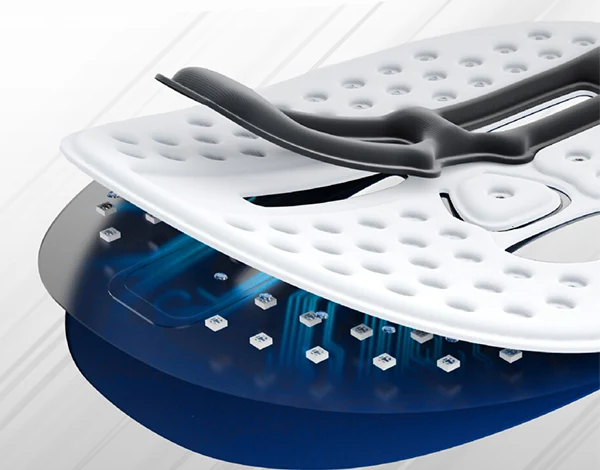Com que frequência você deve usar uma máscara facial de LED para obter resultados seguros e eficazes?
Overview
While individual LED beads theoretically have a lifespan of 30,000 to 50,000 horas, the actual lifespan of a complete LED face mask depends on multiple factors including the quality of the circuitry, the silicone casing, and the control module. For high-quality LED face masks, the practical lifespan is typically 3 to 5 years. Even with daily use of about 15 minutos, the light output remains at around 80%-90% after 2-3 years.
This article will detail the construction of LED face masks, key factors that impact their longevity, differences between high- and low-quality models, and provide a realistic lifespan estimate.
Structure of an LED Face Mask
A high-quality LED face mask typically consists of the following components:
Silicone Mask Body
Material: Medical-grade silicone or rigid ABS plastic.
Função: Serves as the carrier for the LED modules, ensuring a close and comfortable fit for even light distribution across the face.
LED Light Modules
Types and Wavelengths:
Luz vermelha (620–750nm): Boosts collagen production and improves fine lines.
Luz azul (405–420nm): Antibacterial and anti-inflammatory, ideal for acne-prone skin.
Luz amarela (590nm): Brightens skin tone and reduces redness.
Luz do infravermelho próximo (800nm and above): Penetrates deeper to promote cellular metabolism.
Layout: LED beads are strategically placed on the forehead, cheeks, nose, and chin to ensure even light coverage.

Control System
Controller Options: External or integrated controllers, allowing users to switch wavelengths, adjust brightness, and set timers.
Connection Types:
- Wired (via USB)
- Wireless (built-in rechargeable battery with Bluetooth/APP control)
Power Supply
Methods: Built-in rechargeable batteries or external USB power supply.
Wiring and Connectors
Flexible wiring embedded within the silicone body connects LED modules to the control system, maintaining flexibility and durability.
Fastening Mechanism
Adjustable straps ensure the mask remains securely in place during use.
What Factors Affect the Lifespan of an LED Face Mask?
Even though individual LED beads can theoretically last 30,000–50,000 hours, the mask’s real-world lifespan is influenced by several factors:
Quality of LED Beads
Initial Light Output: High-quality LEDs offer strong, stable brightness, whereas low-quality LEDs may start dimmer.
Light Intensity Uniformity: Premium masks provide even light output across all LEDs, while cheaper versions may have dark spots.
Light Decay Rate:
High-quality LEDs: Maintain 80%-90% of their brightness after 2-3 years of regular use.
Low-quality LEDs: May drop to 60%-70% brightness within a year, noticeably reducing skincare effectiveness.
What Is Light Output Degradation?
Light output degradation refers to the gradual weakening of LED brightness over time. Even though the LEDs remain lit, the energy density diminishes, which reduces treatment efficacy.
For example, if red light initially outputs 40mW/cm², but drops to 25mW/cm² after a few years, the skincare results will be significantly less noticeable.
Durability of the Circuit System (Placa FPC)
The flexible printed circuit (FPC) board must withstand repeated bending and stress. Poor-quality boards are prone to cracking, broken connections, and electrical instability, leading to partial or full mask failures.
Aging of the Casing Materials
While medical-grade silicone is durable, it can harden or become brittle after several years due to oxidation and UV exposure, compromising overall protection and fit.
Power Supply and Control Module Lifespan
Built-in lithium batteries typically support 500-800 charge cycles. After 2-3 years, battery performance may decline, requiring replacement or repair.
Heat Management
Good thermal design helps prevent LEDs from overheating, prolonging their lifespan.
Poor thermal management causes internal temperatures to rise, accelerating the degradation of both LEDs and circuitry.
Differences Between High-Quality and Low-Quality LED Face Masks
| Feature | High-Quality LED Mask | Low-Quality LED Mask |
|---|---|---|
| Initial Light Output | Strong and stable brightness | Weak or unstable brightness |
| Light Decay Rate | Retains 80%-90% brightness after 3 years | Drops to 60%-70% brightness within 1 year |
| Lifespan | 3-5 years or longer | Likely to fail within 1-2 years |
| Heat Management | Effective cooling to protect LEDs | Poor cooling, faster aging |
| Overall Performance | Consistent skincare results | Rapid decline in effectiveness |
Conclusion: Realistic Lifespan of an LED Face Mask
Taking into account LED quality, circuit durability, material aging, and heat management,
a high-quality LED face mask typically lasts between 3 e 5 years.
In contrast, lower-quality masks may experience brightness loss, partial failures, or significantly reduced effectiveness within just 1-2 years.


